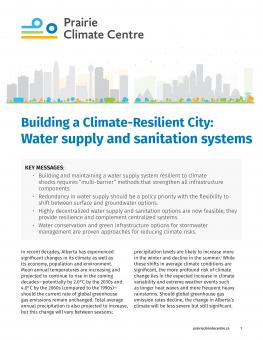
Building a Climate-Resilient City: Water supply and sanitation systems
This policy brief examines ways to build resilience in the water supply and sanitation system as a contribution to urban resilience building.
This policy brief examines ways to build resilience in the water supply and sanitation system as a contribution to urban resilience building.
Its purpose is to highlight areas of best practice for developing a more resilient water supply and sanitation system.
Key Messages
- Building and maintaining a water supply system resilient to climate shocks requires “multi-barrier” methods that strengthen all infrastructure components.
- Redundancy in water supply should be a policy priority with the flexibility to shift between surface and groundwater options.
- Highly decentralized water supply and sanitation options are now feasible; they provide resilience and complement centralized systems.
- Water conservation and green infrastructure options for stormwater management are proven approaches for reducing climate risks.
The Building a Climate-Resilient City series was prepared for the City of Edmonton and the City of Calgary by the International Institute for Sustainable Development and the University of Winnipeg. This series looks makes recommendations for steps that cities can take as part of their municipal adaptation planning to build their resilience to climate change. It explores three key principles of resilience building: robustness (strong design), redundancy (building extra capacity into systems to act as fail-safe networks) and resourcefulness (citizen empowerment).
Participating experts
You might also be interested in
Building a Climate-Resilient City: Economics and finance
This policy brief focuses on economic and financial measures to build cities' resilience to climate change.
Building a Climate-Resilient City: Agriculture and food security
This policy brief focuses on measures related to agriculture and food security that cities can take to build their resilience to climate change.
Building a Climate-Resilient City: Urban ecosystems
This policy brief focuses on measures related to urban ecosystems that cities can take to build their resilience to climate change.
Building a Climate-Resilient City: Transformational adaptation
This policy brief focuses on how cities can build resilience to climate change through transformational adaptation.